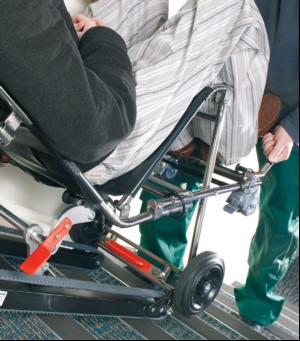If you needed to evacuate your building in an emergency how confident are you that you would be
able to get every single person out quickly and safely? Jon Ellis, managing director of Ferno, advises
on how to put an effective emergency plan in place
If you needed to evacuate your building in an emergency how confident are you that you would be
able to get every single person out quickly and safely? Jon Ellis, managing director of Ferno, advises
on how to put an effective emergency plan in place
Human behaviour in emergency
situations differs and studies
have shown that about two
thirds of the time available to escape is
taken up by a person's initial reaction.
Often there is a delay while people
decide if the alarm is real and only act
after seeing the reaction of others
around them to the developing
situation. It is therefore crucial that an
effective emergency plan is put in place
which considers the needs of those
people who may need extra help to
escape.
Following changes in legislation such as
the Equality Act 2010 and the Fire Safety
Regulatory Reform Order 2005, venues
which are open to the public, no matter
how big or small, are legally obliged to
ensure that people with disabilities or
mobility issues have equal access to
facilities and can safely escape a property
in the event of an incident.
Buildings which have to comply with the
new legislation include offices and shops,
factories and warehouses, residential care
and educational premises, sporting
venues, theatres, cinemas, healthcare and
transport premises and places of assembly.
There also has to be a designated person
whose responsibility it is to ensure
everyone on their site is evacuated,
whether they are employees, visitors,
contractors or members of the public.
The key to making sure everyone is
evacuated safely in an emergency situation
is to be prepared and know exactly what
needs to be done and who needs to do it.
It is essential that every member of staff
knows how to act, where to direct people,
and what equipment is available to get
everyone off the premises safely.
Evacuation audits
Evacuation audits, which consider all
aspects of an emergency evacuation
including the management of disabled
people, treating the injured, the effects of
smoke, lighting and crowd control, can be
carried out by a competent employee or a
specialist consultant from outside the
business.
Any building, whether it is a major
arena or office block, will benefit from an
evacuation audit. Even property managers
who think they have all the correct
procedures in place may be surprised by
what else they can do to aid a safe and
speedy evacuation should an emergency
situation arise. Every audit and assessment
will vary slightly to accommodate the
different types of venue. However, in
general, the purpose is to understand and
identify any potential hazards within the
building which may prevent a safe and
quick evacuation and how these can be
overcome.
Putting someone in charge
Legislation stipulates that there has to be a
person in charge of ensuring that a
building is evacuated fully in the event of
an emergency. In a place of work, that
person should be aware of the location of
anyone working in the building that is
disabled, has mobility issues and even
who is pregnant. A plan should then be
put in place for their route of evacuation
and equipment should be readily available
to assist in this; for example a stretcher or
an evacuation chair located at the top of
each staircase, which are capable of
manoeuvring downstairs.
Those people who need assistance
should be made aware of the
arrangements as should those who would
be expected to help them make their
escape. This will save precious minutes in
the moments after the alarm is raised. A
different scenario presents itself where
large numbers of the general public may
gather in one place, for instance at a
sporting event or theatre. Such places are
not exempt from legislation and likewise
there has to be an appointed person
responsible for ensuring a swift
evacuation.
Disabled areas should be easily
accessible via level or ramp access, and
within a fire safe zone where there are no
combustible materials. Designated refuge
zones should be identified and located
around the venue so that people who need
assistance and those who will help
evacuate them in the event of an
emergency can convene. These refuge
zones also present an ideal place to store
equipment like evacuation chairs and
stretchers so that they are to hand in time
of need.
When an emergency occurs, you need
procedures and equipment in place which
you can rely on. They can be implemented
into any type of building and tailored to
suit whatever sector you operate in.
Ultimately, they can help to prevent tragic
loss of life should a dangerous incident
ever occur.


